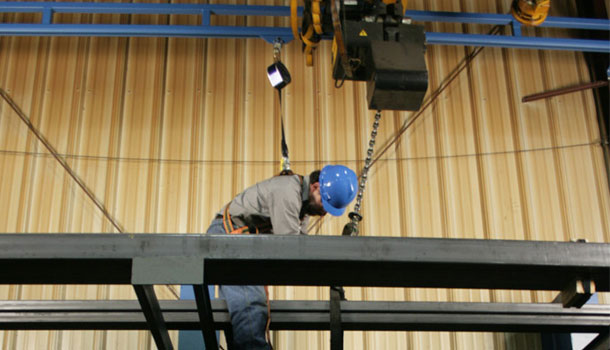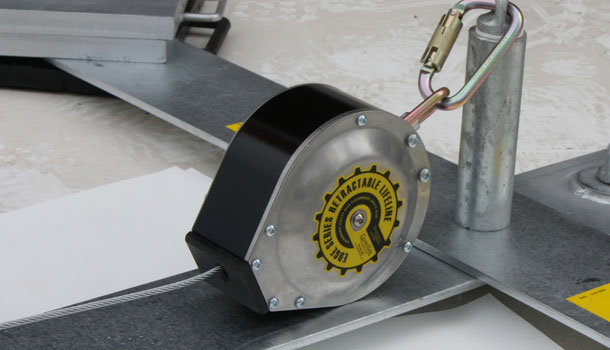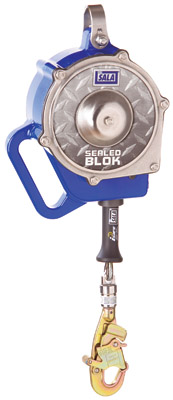How to Safely Use a Retractable Lanyard

Even with the best of intentions, Self-Retracting Lifelines (e.g. SRL’s) can cause more injuries than almost any other kind of fall protection when they aren't used properly. Using an SRL gives the feeling of extra assurance because you’re clipped in, however, if proper measures are not taken, you might as well not be protected at all.
Before you ever need to do work that requires using an SRL, it is crucial that you have received training and understand how to use it safely. Here is a quick refresher and five key points that you need to know when using your SRL in the workplace.
1. Assess the Work Being Done
Anytime you are asked to do a task that is at heights (OSHA defines this as 48” or higher off the lower surface), you should ask the question, “Can this be done by without putting a worker at height?”
If it is determined that the task cannot be performed from the ground level, then you must determine the type of fall protection that is needed. The best resource for deciding this is using the hierarchy of controls. We have an in-depth blog post that focuses on Elimination and Substitution that I would recommend adding to your reading list.
“The safest PPE are the ones you never need to use.”
If the decision is made that the only way to do the task is by working at heights and utilizing a fall arrest system, then an SRL may be a suitable means of PPE.
2. Ensure Attachment Point Is Safe
 The next step is to ensure that whatever the SRL is attaching to is safe. There should be documentation of the latest inspections and training on how to visually inspect this attachment before each use. This could be an anchor point, an overhead rigid rail system, a horizontal lifeline, etc.
The next step is to ensure that whatever the SRL is attaching to is safe. There should be documentation of the latest inspections and training on how to visually inspect this attachment before each use. This could be an anchor point, an overhead rigid rail system, a horizontal lifeline, etc.
Remember, if anything looks wrong or out of place, DO NOT USE. Report it immediately to your supervisor or EHS officer. This could be something like rust, frayed wiring, discoloration, cracks, rips, anything that looks compromising to the system.
3. Inspect Your SRL
Similarly to the attachment, SRL’s need to be inspected before each use and should have proper documentation associated with it. Inspect it thoroughly and do not use if you see anything that might look wrong with it. It is important to even pull out the lanyard and inspect a portion of that as well as the shell/casing and carabiners.
“You should NEVER use an SRL unless you have been completely trained by a competent person on how to use it.”
You will then need to confirm that this is the correct type of SRL for the job. Key factors to confirm are:
- Is this a Class A SRL? Does it need to be?
- Is this SRL designed for leading-edge work?
- Are there other hazards that may affect my SRL?
Class A SRL’s are designed to stop a worker from falling within 24”. This then becomes a question of your fall distance. Make sure you assess your fall clearance correctly.
Leading-edge SRL’s are designed differently to allow you to fall over an edge and not experience failure in the system. If you are doing leading-edge work, make sure your SRL is designed for a leading-edge.
This might include hazards such as working around high voltage equipment or welding.
4. Ensure proper PPE
 Anytime you use an SRL, proper PPE needs to be combined with it. This is most commonly going to be the harness you attached your lanyard to. As you may already know, there are hundreds of different types of harnesses out there, all for different applications, locations of D-rings, sizes, water bottle accessories, you name it!
Anytime you use an SRL, proper PPE needs to be combined with it. This is most commonly going to be the harness you attached your lanyard to. As you may already know, there are hundreds of different types of harnesses out there, all for different applications, locations of D-rings, sizes, water bottle accessories, you name it!
As with everything else, inspecting your harness before each use is mandatory. Check your harness, make sure the D-rings are in the proper positions, ensure that it fits correctly, and go work safely.
5. Have A Rescue Plan
Last, but certainly not least, have a rescue plan. In the unfortunate case that you were to fall, assuming everything in your fall arrest system functioned correctly, you will be left dangling in the air with no serious injuries.
However, the question becomes, how do you get down? You should never be working at heights alone, so whoever is with you and/or supervising the work should be aware of the fall. Then the plan should go into effect immediately. Left hanging for too long can create new injuries and health problems.
It is important to remember that, as with any fall arrest PPE, training and inspection are king. You must understand your work, your equipment, and how to perform the job safely before any use of an SRL. If you are ever unsure about something or have questions, it is your duty to address them and not put your life on the line.



